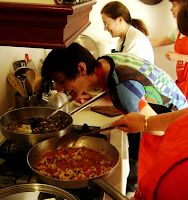 Compare that supermarket uniformity then, with the sensuous fruit dangling from an Italian vine. Nigel Slater describes its perfume, in his book Tender - Volume 1 as ‘almost erotic’. Imagine these beauties still exuding the sun’s warmth, like fat ladies almost bursting from their corsets with juiciness and fragrance. This is the true smell of a tomato and an Italian Cooking Class may well convince you to abandon mass produced red pretenders.
Compare that supermarket uniformity then, with the sensuous fruit dangling from an Italian vine. Nigel Slater describes its perfume, in his book Tender - Volume 1 as ‘almost erotic’. Imagine these beauties still exuding the sun’s warmth, like fat ladies almost bursting from their corsets with juiciness and fragrance. This is the true smell of a tomato and an Italian Cooking Class may well convince you to abandon mass produced red pretenders.A temperate climate just doesn’t feed the tomato with the possibilities its ancestral wild abandon and promiscuity pines for; the classic tomato will actually look as if it’s been on a journey and will therefore release its exotic story as your mouth fills with pinkish pulp. Yes, I am waxing lyrical about a plant once considered a weed in its native Peru, where its original name ‘tomatl’ meant ‘swelling fruit’; no wonder it has been forever linked with a certain sensuality and hedonism.
After Peru, tomatoes made their way to Mexico; Cortez, a Spaniard, carried a variety to Europe; although dates are uncertain, what we do know is that an Italian botanist and physician, Pietro Andrea Mattioli christened it Pomo d’oro in the middle of the 16th century. Surprisingly our immigrant wasn’t initially used in cooking; it was incorporated instead into table decorations for many years before finally falling into a Florentine pot. Although there is a Napolitano recipe book outlining ways with tomatoes from around 1692.
 So, consider the straining beast you have in your hands before deciding exactly what to do with her. Cooks at an Italian Cooking Class may well suggest the most unctuous way of preserving the vivacity and seductive quality of this fruit is to make a classic tomato sauce. In fact, after a few minutes internet research you will be inundated with different recipes; it seems every chef has a secret but really the only really important consideration is to find your hot faced plump Italian beauty, bursting from her skirts and only then can you really anticipate creating something worth eating naked.
So, consider the straining beast you have in your hands before deciding exactly what to do with her. Cooks at an Italian Cooking Class may well suggest the most unctuous way of preserving the vivacity and seductive quality of this fruit is to make a classic tomato sauce. In fact, after a few minutes internet research you will be inundated with different recipes; it seems every chef has a secret but really the only really important consideration is to find your hot faced plump Italian beauty, bursting from her skirts and only then can you really anticipate creating something worth eating naked.I offer you first an uncooked tomato sauce by the doyenne of Italian cooking Patience Gray from her fascinating book, Honey From A Weed first published in 1986 but reprinted in 2005: Salsa Cruda Di Pomodori.
She suggests you gather tomatoes in early July when they are newly ripe and then scald them in boiling water, around a kilo will do. Drain after a minute, quench with cold water, remove the skin de- seed then chop the flesh.
Pound 2 or 3 cloves of garlic with a little salt and a seared, skinned and seeded hot green pepper, then add basil leaves, chopped tomatoes and the best olive oil you can lay your hands on. Apply this dressing, unheated, to steaming pasta the moment it is drained. There’s simplicity in this celebration of early summer which shows off the intensity of the finest Italian ingredients.
However, if it’s sensuous memories of tanned skins, banks of wild thyme and hot days you wish to conjure then Elizabeth David has this suggestion from Summer Cooking: oil and butter in a large pan, followed by sliced onion, carrots and celery, when the onions have coloured add quartered tomatoes and salt. Cook until it almost sticks to the pan, sieve, bottle, then steam for 3 hours in a large pan of water.
If you can’t wait, cook until thick but add basil, garlic, a little port or masala and possibly a pinch of sugar, then add to pasta. What could be easier?
Our love affair with the tomato is on-going and Italy is the place to sniff, touch, taste and cook and at our Italian cooking classes you will find the ultimate place to experiment and produce a sauce fit for this wise and wizened traveller.




1 comment:
wow what a great post! It is so true that the quality of the base ingredient makes or breaks the sauce - a divine read :)
Post a Comment